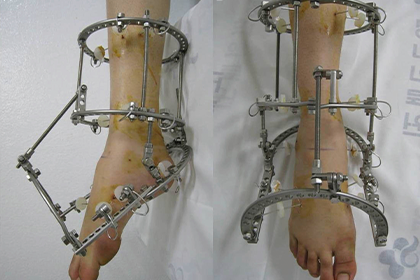Ilizarov
Overview
The Ilizarov method, named after the Russian orthopedic surgeon Dr. Gavriil Ilizarov, is a surgical technique used for limb lengthening, deformity correction, and fracture healing. The Ilizarov apparatus, a device invented by Dr. Ilizarov, plays a key role in this method.
The Ilizarov method is considered a highly effective and versatile technique for addressing various orthopedic conditions. It requires careful planning, precise surgical technique, and dedicated postoperative care. The decision to use the Ilizarov method is made based on the specific needs of the patient and the nature of the orthopedic condition being treated.

Why it's done
Ilizarov may be recommended for several reasons, including:
- In cases where a limb is congenitally shorter than normal, the Ilizarov method can be used to gradually lengthen the bone, helping achieve more balanced limb lengths.
- After trauma, such as a fracture that results in limb shortening, the Ilizarov method can aid in restoring the normal length of the limb.
- The Ilizarov method is effective in correcting angular deformities in the legs or arms, such as bowlegs (genu varum) or knock-knees (genu valgum).
- It can also be used to correct rotational deformities where the alignment of the limb is abnormal.
- In cases where fractures fail to heal (nonunion) or heal in a malaligned manner (malunion), the Ilizarov method can provide a means to stabilize the fracture site and promote proper bone healing.
- For complex fractures with significant soft tissue damage or open wounds, the Ilizarov method helps in managing the fracture without the need for extensive surgical exposure.
- The Ilizarov method is particularly associated with the technique of distraction osteogenesis, where the gradual separation of bone segments stimulates new bone formation in the gap, allowing for controlled lengthening.
- In cases of chronic osteomyelitis (bone infection), the Ilizarov method can be employed to stabilize the affected bone, promote healing, and manage the infection.
Risk
Ilizarov can pose potential risks and complications. Some of these include:
- Pin Loosening
- Infection
- Pin Tract Infection
- Joint Stiffness
- Nerve or Blood Vessel Damage
- Delayed Union or Nonunion
- Psychological Impact
- Joint Contractures
- Skin Problems
- Patient Compliance
- Hardware Failure
How do I get ready for Ilizarov?
Preparing for Ilizarov involves several steps to ensure a smooth procedure and recovery:
- Schedule a thorough consultation with the orthopedic surgeon who will perform the Ilizarov procedure. Discuss your medical history, current medications, and any allergies.
- Undergo necessary diagnostic tests, such as X-rays or imaging studies, to provide detailed information about the affected limb and guide the surgical planning.
- Complete a comprehensive medical evaluation to assess your overall health and identify any pre-existing conditions that may affect the procedure or anesthesia.
- Review your current medications with your healthcare provider. Adjustments may be necessary, especially for medications that affect blood clotting.
- Wear loose, comfortable clothing on the day of the procedure. This makes it easier to change into a gown if necessary.
- Bring necessary personal items, including identification, insurance information, and any documents provided by your healthcare team.
- Avoid wearing makeup and jewelry on the day of the procedure. This helps with the application of monitors and ensures aseptic conditions.


